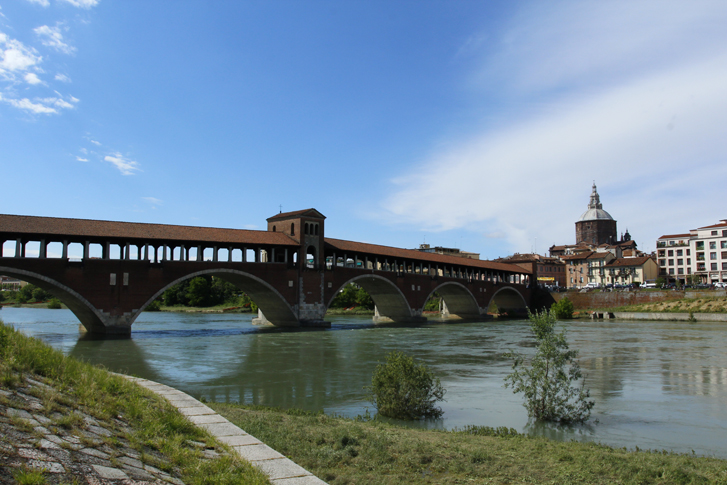
Description
The Covered Bridge is an ancient city gate, part of the defensive ancient river port, the point which links the historic center of Pavia with the ancient and picturesque Borgo Ticino, a short walk from the riverbed.
The Covered Bridge on Ticino River connects the historical city center of Pavia with the ancient picturesque medieval village of Borgo Ticino. It is composed of five arches, two gates at the far end and a small religious chapel in the center. The bridge was rebuilt several times over different eras. In the Roman times, during the reign of Emperor Augustus, the first bridge was established. This bridge connected the two banks of the river in the same point where today can be seen housing the modern Covered Bridge. The Ancient bridges are easily visible during the dry periods of Ticino.
In 1352, on the ruins of the Roman bridge, John Ferrara and Jacopo da Cozza designed and reconstructed a new bridge. In 1354 the project was completed and the bridge consisted of ten arches and two guard towers at the far end. This can also be seen in the works of Bernardino Lanzani inside the church of San Teodoro.
In 1583, at the behest of the Visconti, the cover was replaced by a new roof and supported by one hundred mini granite pillars. In the seventeenth century, during the Spanish domination, the first arch to the city and the first arch on the side of the village were included, and then closed for the construction of the Spanish walls, inside the ramparts.
Eventually in 1599, they were added to an entrance gate on the bank of Borgo Ticino and, in 1745, the central pillar of the bridge, a small chapel, in the baroque style was created in honor of St. Giovanni Nepomuceno.
The bridge was damaged in 1799 however it was then renovated in 1811 and in 1822 given a neo-classical portal on the north side, designed by Amati, which was conceived as a triumphal arch to celebrate the House of Austria.
During the Second World War the fourteenth-century bridge was partially destroyed and, after a long debate, the decision was made to restore to its complete demolition in the fear of a collapse that could see the overflow of Ticino. The construction of the new bridge began in 1949 and was unveiled in 1951.
The current bridge was constructed about 30 meters downstream of the previous year. The arches are wider and taller and were decreased to five arches instead of ten arches that existed in the medieval design. The bridge was also shortened as it now follows a path that is directed towards the flow of the river. The older bridge followed the line that joins New Road in the city center, Via dei Mille, Borgo Ticino. On the central pier a new chapel was built which houses the wooden statue of St. John Nepomuk. The changes that were implemented had the aim of improving the functioning of the bridge and simultaneously facilitating the flow of the water. For safety reasons the viability of the bridge has recently been reduced, with the exception of city buses, to one single direction.
Insights
| Itineraries |
|---|
| Pavia: art, culture and tradition |
| Where to sleep |
|---|
| Where to eat |
|---|







